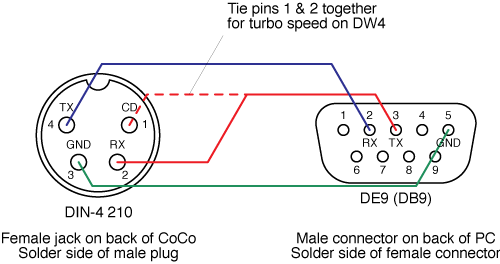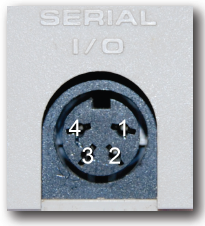MediaWiki:Sitenotice:
2024-03-02: The wiki ran out of disk space, so things were not working. This has been resolved by adding another 5GB of quota ;-) Thanks to Tim Lindner for reporting the issues.
2020-05-17: If a page gives you an error about some revision not being found, just EDIT the page and the old page should appear in the editor. If it does, just SAVE that and the page should be restored. OS-9 Al (talk) 12:22, 17 May 2020 (CDT)
How to build a DriveWire serial cable
| WELCOME |
|---|
| Looking for CoCo help? If you are trying to do something with your old Color Computer, read this quick reference. Want to contribute to this wiki? Be sure to read this first. This CoCo wiki project was started on October 29, 2004. --OS-9 Al |
See Recent Changes. | About this site. | Join the E-Mail List or Facebook Group. | Contact me with updates/questions.
This page was last updated on 11/22/2021. Total Pages: 729. Total Files: 993.
Home / Hardware - How to build a DriveWire serial cable
General cable information
When connecting a CoCo to a DriveWire 3 or 4 server you will need a particular serial cable. Here are two ways to build such a cable. USB to serial adapters generally work well.
Note : The physical cable connecting the CoCo to the Server is recommended to be no longer than 10 feet in length..
At a minimum, the serial line shall carry the following four wires:
- Ground
- Vcc
- RD (Receive Data)
- TD (Transmit Data)
A 4 pin DIN connector shall be on one end of the cable which will mate to the jack on the back of the CoCo marked “Serial I/O”. The other end of the cable shall be either a DB-9 or DB-25 female connector which will mate to an appropriate serial port on the Server.
The following table shows the connections between the CoCo 4 pin DIN connector to either a 9-pin DB-9 serial connector or a 25-pin DB-25 serial connector :
| CoCo DIN connector | DB-9 | DB-25 |
|---|---|---|
| Pin 1 (CD) | Pin 3 (TX) | Pin 2 (TX) |
| Pin 2 (RX) | Pin 3 (TX) | Pin 2 (TX) |
| Pin 3 (GND) | Pin 5 (GND) | Pin 7 (GND) |
| Pin 4 (TX) | Pin 2 (RX) | Pin 3 (RX) |
| Coco DIN connector | Legend |
|---|---|
|
Direct USB-A male RS232 cable converter to 4-Pin DIN male cable
Parts :
To connect this the FTDI cable wires yellow, orange, and black are used :
- Yellow is connected to the DIN pin 4
- Orange is connected to DIN pin 2
- Black is connected to DIN pin 3
This has been tested and worked in GNU/Linux and Windows to 115,200 kbps.
USB-A male to RS-232 DB9 female serial adapter, DB9 male to 4-Pin DIN male cable
Parts :
- USB male to DB-9 female RS232 female serial adapter (example adapter) - needed for modern PCs which most probably don't have a DB9 serial port. Older PCs have a male DB9 connector on board.
- DB9 male connector
- Solderable 4-pin DIN plug (example)
- 4 conductor cable
This cable may be built based upon the following diagram :

USB to Serial (DB-9) converters range in price from about $10 - $20 and can be purchased from most electronics stores and online. If they don't have it on the shelf, ask someone and they can most likely order it for you. You will still need the cable above as this is just an adapter to be able to connect it to PC's with no DB-9 male serial port.
Alternatively, you can also still purchase an add-on PCI or PCIx serial card. TigerDirect and NewEgg still stock a large selection of these cards. The internal serial cards tend to offer better data transfer rates than the USB to Serial adapters in testing.
Source
- Scott Adams (direct FTDI to 4-Pin DIN cable)
- Tandy Service Manual - Color Computer 3 NTSC/Pal Version - p. 47-48
- Drivewire physical interface requirements - from the [DriveWire Specification https://sourceforge.net/p/drivewireserver/wiki/DriveWire_Specification] (DB9 to 4PN-DIN male)
